Girona (ship)
La Girona was a galleass of the 1588 Spanish Armada that foundered and sank off Lacada Point, County Antrim, on the night of 26 October 1588, after making its way eastward along the Northern Irish coast. The wreck is noteworthy for the great loss of life that resulted, and the treasures recovered.
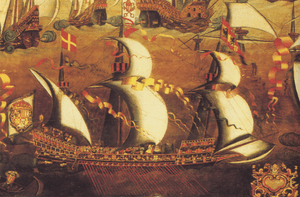 Galleass La Girona | |
| History | |
|---|---|
| Name: | La Girona |
| Homeport: | A Coruña |
| Fate: | Wrecked 26 October 1588 |
| General characteristics | |
| Class and type: | 50-gun galleass |
| Capacity: | 1,300+ emergency loading |
| Troops: | 186 transported |
| Complement: | 531 sailors and rowers |
| Armament: | 50 bronze and iron cannon |
| Notes: | over 1300 aboard, 9 survived |
.jpg) Wreck of the Girona (Ulster Museum Exhibit Painting) | |
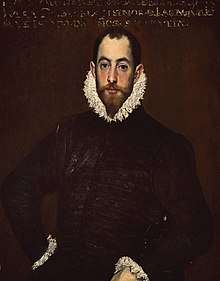
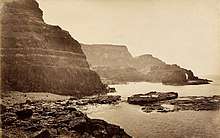
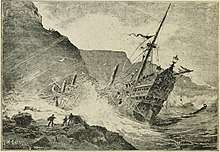
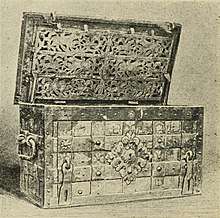
.jpg)
Introduction
La Girona (/lɑː xɪˈrɔːnɑː/) was named after the Girones family, who at the time had just become Dukes of Osuna and viceroys of Naples[1]; thus it is not to be confused with Girona, the Catalan name of the city and province of Gerona in Spain. Its captain was Hugo de Moncada y Gralla, knight of the Order of Malta[1].
Shipwreck
La Girona had anchored in Killybegs harbour, Donegal, with a damaged rudder. With the assistance of an Irish chieftain, MacSweeney Bannagh, she was repaired and set sail for Scotland on 25 October, with 1,300 men on board, including Alonso Martínez de Leyva, knight and trece of the Order of Santiago[1].
After Lough Foyle was cleared, a gale struck and La Girona was driven on to Lacada Point and the Spanish Rocks (as they were known, thereafter) in County Antrim, on the night of 26 October 1588. Of the estimated 1300 souls on board, there were nine survivors. 260 bodies washed ashore and were buried in a common grave at the local churchyard.
The survivors were sent on to Scotland by the local clan leader Sorley Boy MacDonnell of Dunluce Castle, which was situated just to the west on the Giant's Causeway cliffs overlooking the coast. From there, MacDonnell is also believed to have conducted the first clandestine salvage efforts on the shipwreck.[2]
Salvage
In 1967-68, off the coast of Portballintrae (Port-na Spaniagh bay), a team of Belgian divers (including Robert Sténuit, the world's first aquanaut), located the remains of the wreck and brought up the greatest find of Spanish Armada treasure ever salvaged.[3][4] The underwater site was designated under the Protection of Wrecks Act on 22 April 1993.
Commemoration
The wrecking of La Girona is officially commemorated with a period illustration on the reverse side of sterling banknotes issued by the First Trust Bank in Northern Ireland.[5]
Ulster Museum Exhibit, Belfast
"Treasures from the Girona"
Gold and silver coins, jewelry, armaments, and utilitarian objects from the Spanish galleass, Girona, are on permanent display at the Ulster Museum (National Museums of Northern Ireland) in Belfast.
- Ulster Museum, Belfast
- Girona cannons
- Girona cannon
- Iron cannon of Duquesa Santa Ana
- Iron cannon of Duquesa Santa Ana
- Girona cannons
- Girona cannon
- Salamander pendant
.jpg) Girona shipwreck
Girona shipwreck
See also
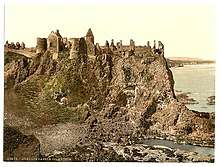
- Spanish Armada
- Spanish Armada in Ireland
- List of Ships of the Spanish Armada
- Hugo of Moncada i Gralla
- Ulster Museum
- Galleass
- Dunluce Castle
References
- "La busca de galeones. Pasado y actualidad". Conference by Hugo O'Donnell y Duque de Estrada of the Real Academia de la Historia, 6th November 2019.
- "La Girona" (PDF). # Annual Report of the Advisory Committee on Historic Wrecks, 2005. Advisory Committee on Historic Wreck Sites. p. 35. Retrieved 1 November 2008.
- Sténuit, Robert (1973). Treasures of the Armada. Trans. Francine Barker. New York: E. P. Dutton & Co. ISBN 0-525-22245-6.
- "colerainebc.gov.uk". Archived from the original on 27 September 2007. Retrieved 27 April 2007.
- "First Trust £10 1998". Ron Wise's Banknote World. Archived from the original on 3 June 2011. Retrieved 1 November 2008.
External links
| Wikimedia Commons has media related to Galleass Girona. |
- Girona Tribute
- Gold of the Girona
- Photograph of Lacada Point where the Girona foundered
- Girona's shipreck(In catalan) Revista de Girona 214/2002